Method for manufacturing semiconductor device
a semiconductor and manufacturing technology, applied in the direction of semiconductor devices, basic electric elements, electrical equipment, etc., can solve the problems of crystalline silicon film, substrate cracks, base protective film, etc., to reduce the number of defective semiconductor devices, and reduce the tensile stress of the substrate surfa
- Summary
- Abstract
- Description
- Claims
- Application Information
AI Technical Summary
Benefits of technology
Problems solved by technology
Method used
Image
Examples
embodiment mode 1
[0040]As shown in FIG. 1A, over one surface of a substrate 100 having an insulating surface, insulating films 101 and 102 which serve as base protective films are formed, and an amorphous semiconductor film 103 is formed over the insulating film 102. Next, in order to remove hydrogen of the amorphous semiconductor film, the amorphous semiconductor film is heated. At this time, the substrate and the insulating films which serve as base protective films are also heated. The insulating films 101 and 102 which serve as base protective films and the amorphous semiconductor film 103 are formed such that the total stress of the insulating films 101 and 102 and the amorphous semiconductor film 103 after the heating is −500 N / m to +50 N / m, inclusive, preferably −150 N / m to 0 N / m, inclusive.
[0041]As the substrate 100 having an insulating surface, a substrate which has a thermal expansion coefficient of greater than 6×10−7 / ° C. and less than or equal to 38×10−7 / ° C., preferably greater than 6×...
embodiment mode 2
[0087]In this embodiment mode, a liquid crystal display device which is an example of a semiconductor device will be described with reference to FIGS. 4A to 4D and FIGS. 5A to 5C.
[0088]As in Embodiment Mode 1, the insulating film 101 is formed over the substrate 100 which has a thermal expansion coefficient of greater than 6×10−7 / ° C. and less than or equal to 38×10−7 / ° C., preferably greater than 6×10−7 / ° C. and less than or equal to 31.8×10−7 / ° C., and the amorphous semiconductor film 103 is formed over the insulating film 101, as shown in FIG. 4A. Here, an AN100 substrate with a thermal expansion coefficient of 38×10−7 / ° C. and a thickness of 0.7 cm is used as the substrate 100. Further, as the insulating film 101, a silicon nitride film containing oxygen with a thickness of 40 to 60 nm and a silicon oxide film containing nitrogen with a thickness of 80 to 120 nm are each formed by a plasma CVD method. Further, as the amorphous semiconductor film 103, an amorphous semiconductor f...
embodiment mode 3
[0111]In this embodiment mode, a manufacturing process of a light emitting device having a light emitting element which is an example of a semiconductor device will be described.
[0112]As shown in FIG. 6A, the thin film transistors 225 to 227 are formed over the substrate 100 with the insulating film 101 therebetween using similar processing steps to those in Embodiment Mode 2. Further, the silicon oxide film 231, the silicon nitride film 232, and a silicon oxide film 233 are stacked as a first interlayer insulating film which insulates the gate electrodes and wirings of the thin film transistors 225 to 227. Further, wirings 308, 309, 310, 311, 312, and 313 which are connected to a semiconductor film of the thin film transistors 225 to 227, and a connecting terminal 314 are formed over the silicon oxide film 233, which is a part of the first interlayer insulating film.
[0113]Next, a second interlayer insulating film 315 is formed over the first interlayer insulating film, the wirings ...
PUM
| Property | Measurement | Unit |
|---|---|---|
| thicknesses | aaaaa | aaaaa |
| thicknesses | aaaaa | aaaaa |
| thicknesses | aaaaa | aaaaa |
Abstract
Description
Claims
Application Information
 Login to View More
Login to View More - R&D
- Intellectual Property
- Life Sciences
- Materials
- Tech Scout
- Unparalleled Data Quality
- Higher Quality Content
- 60% Fewer Hallucinations
Browse by: Latest US Patents, China's latest patents, Technical Efficacy Thesaurus, Application Domain, Technology Topic, Popular Technical Reports.
© 2025 PatSnap. All rights reserved.Legal|Privacy policy|Modern Slavery Act Transparency Statement|Sitemap|About US| Contact US: help@patsnap.com



